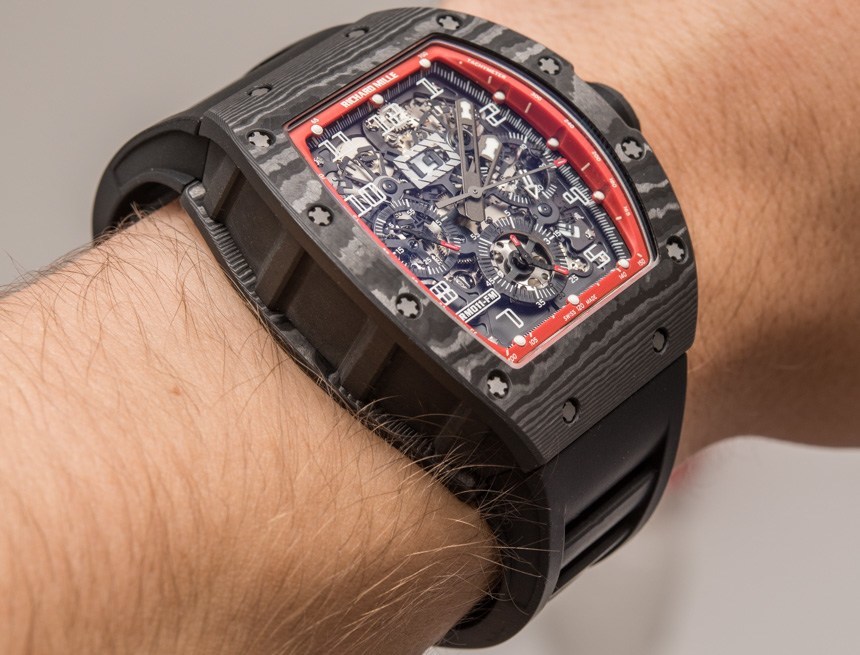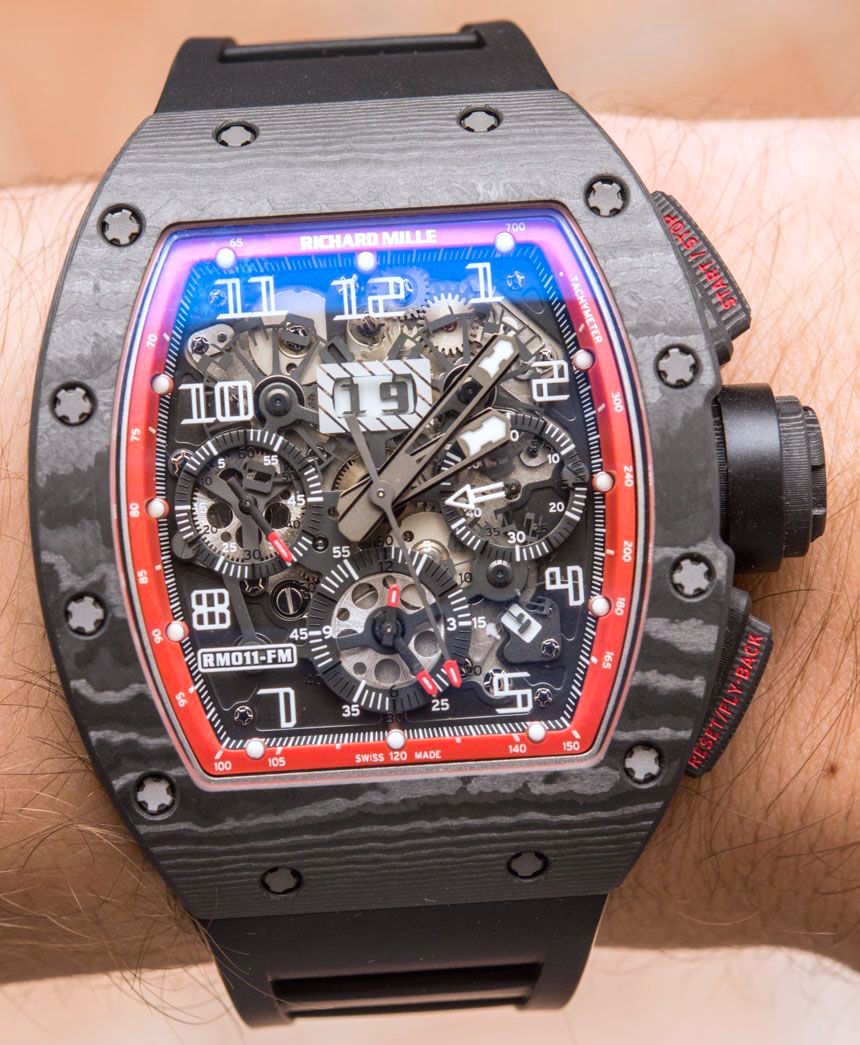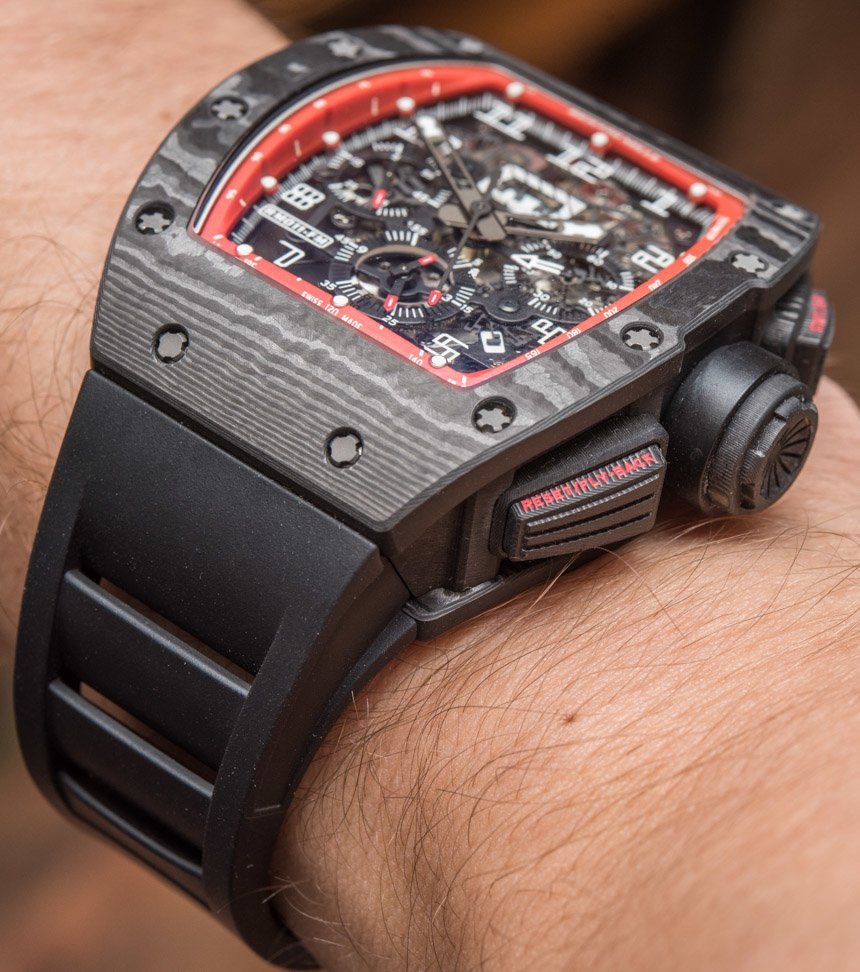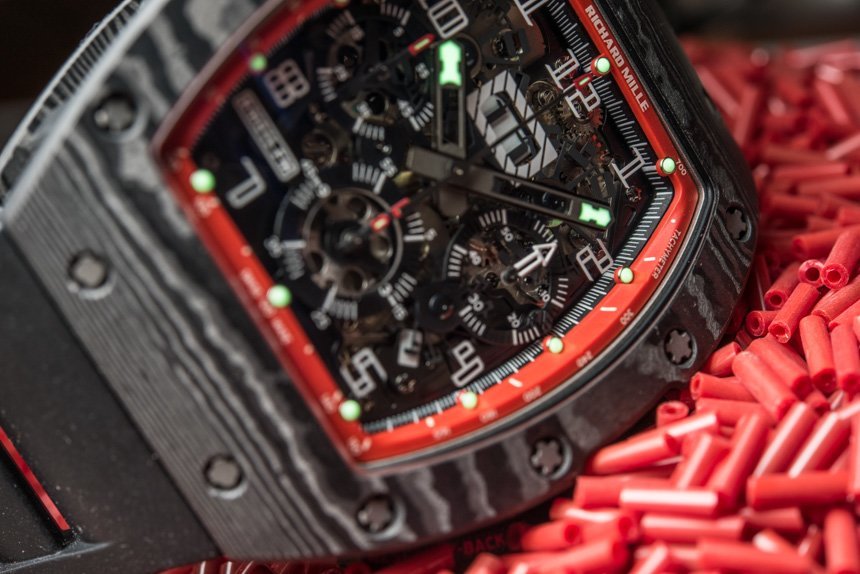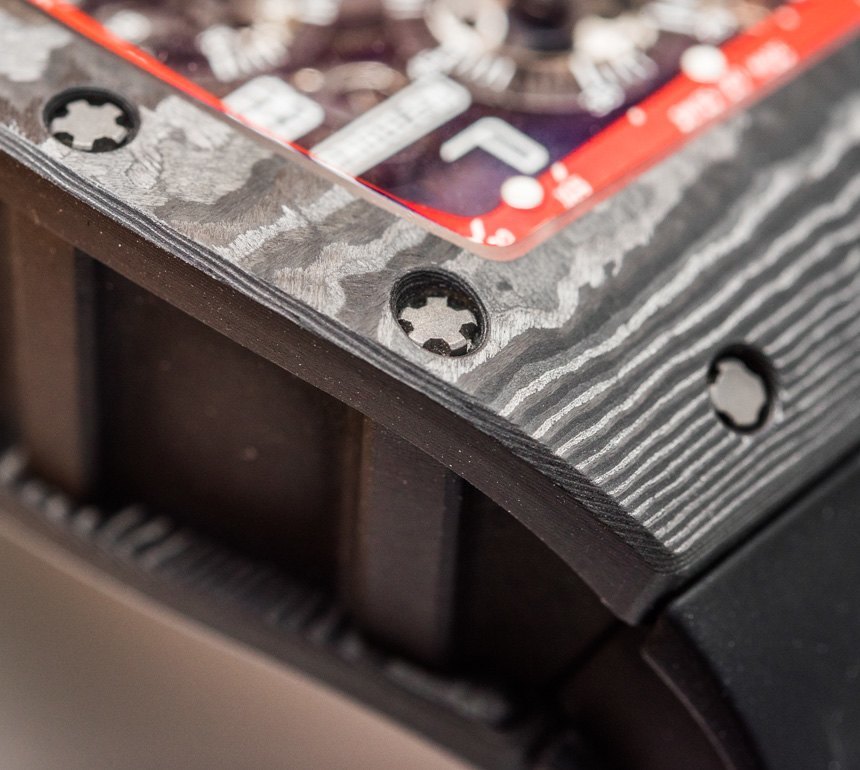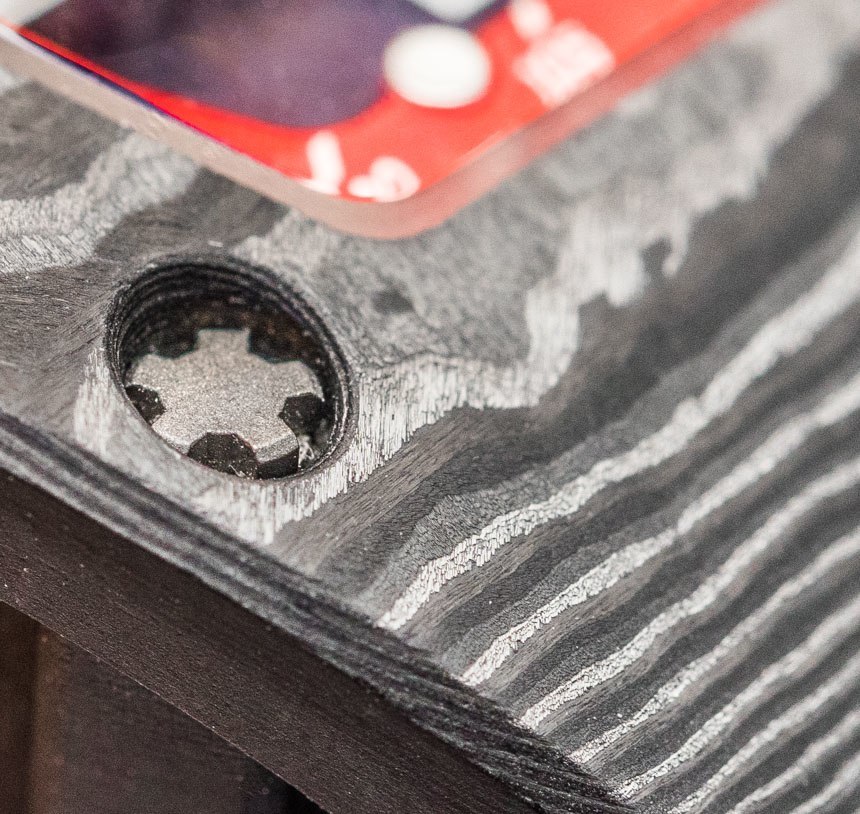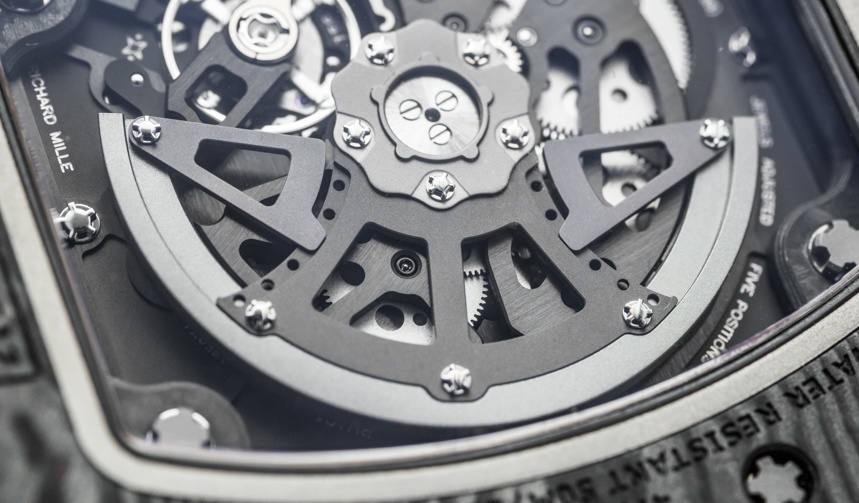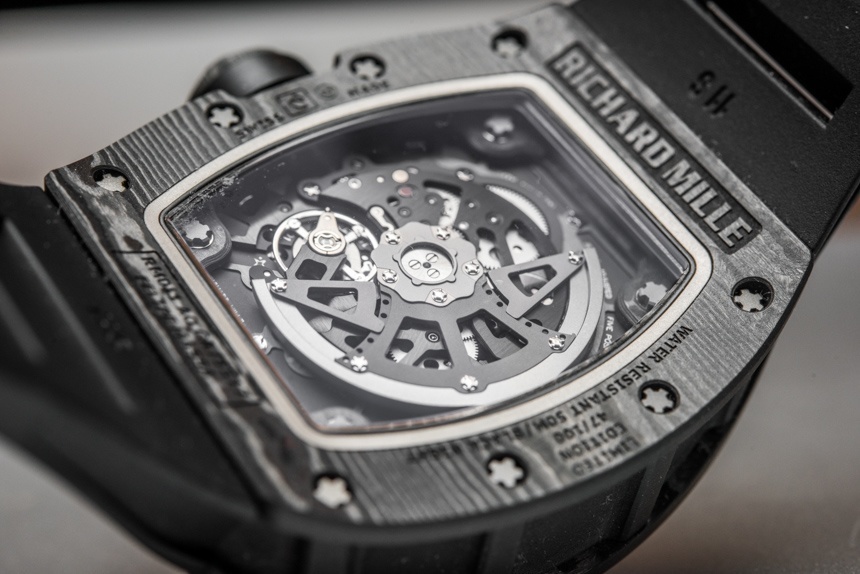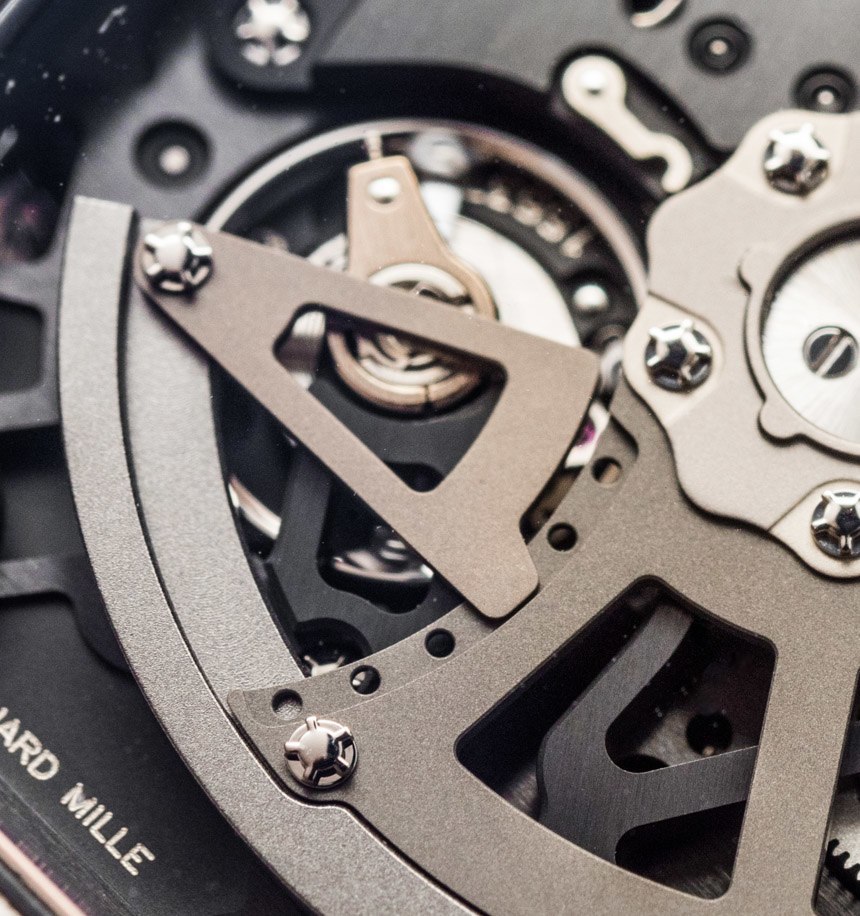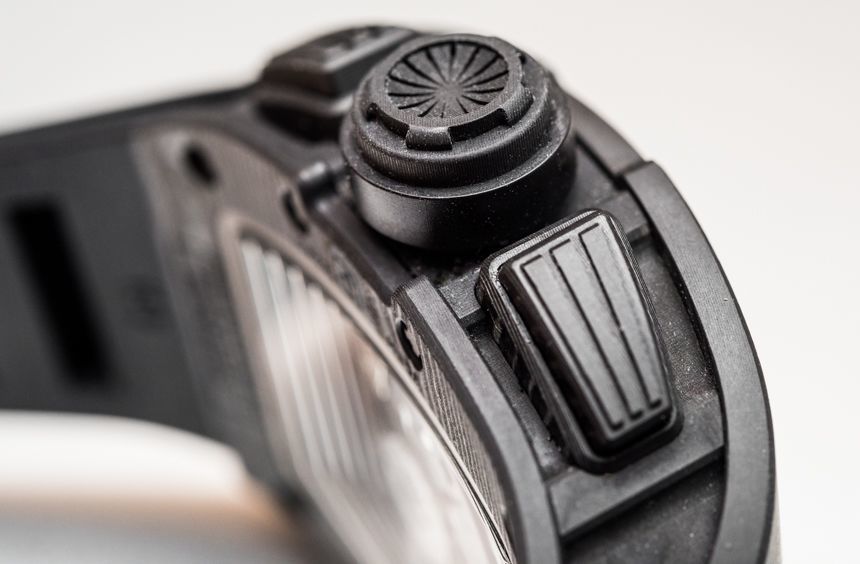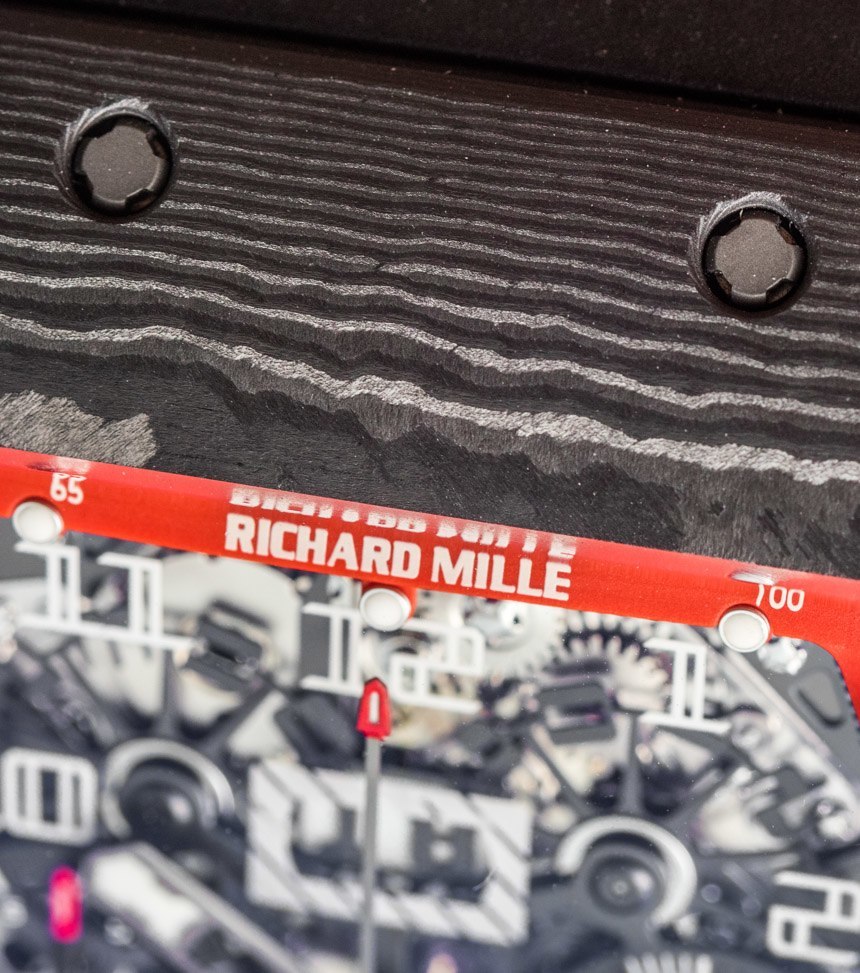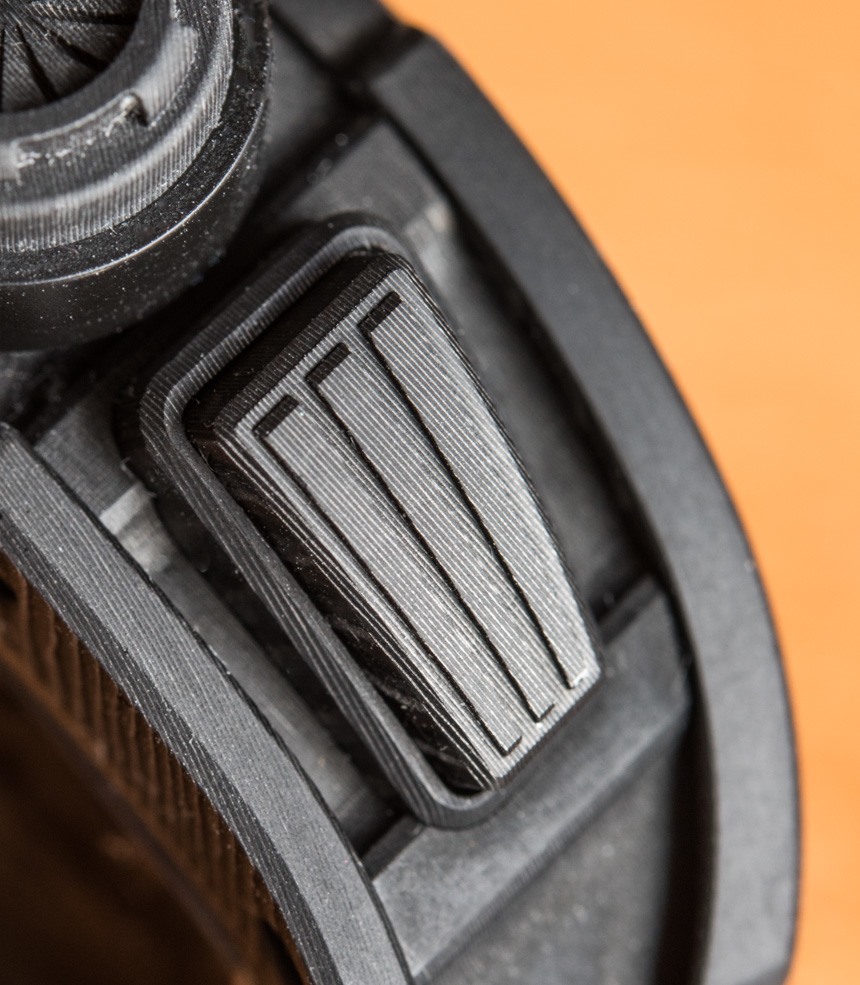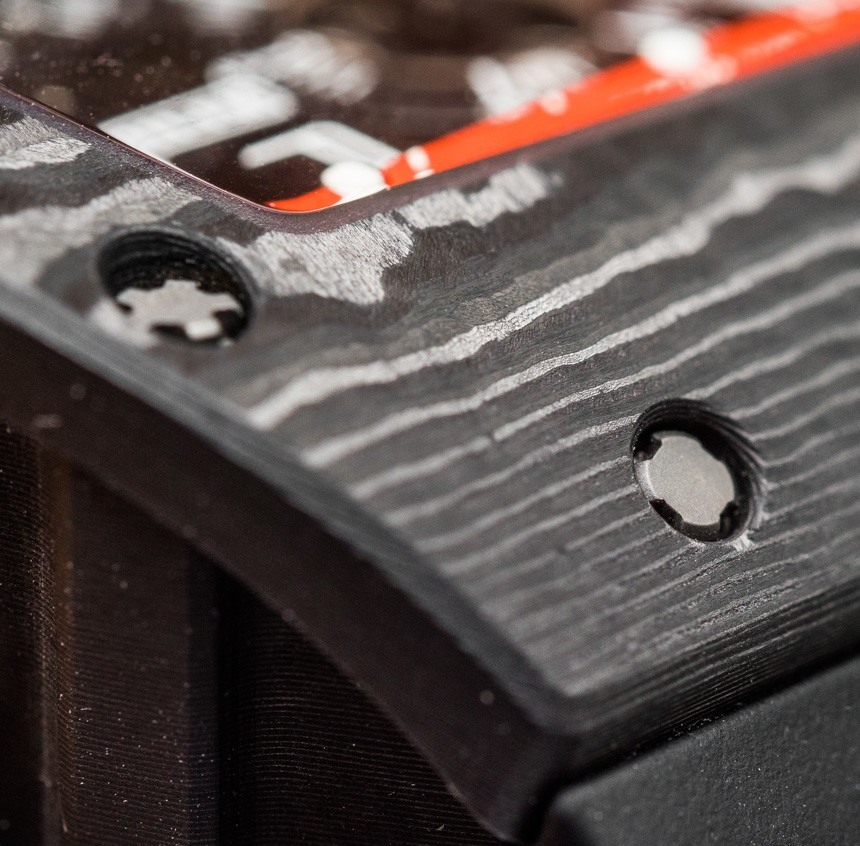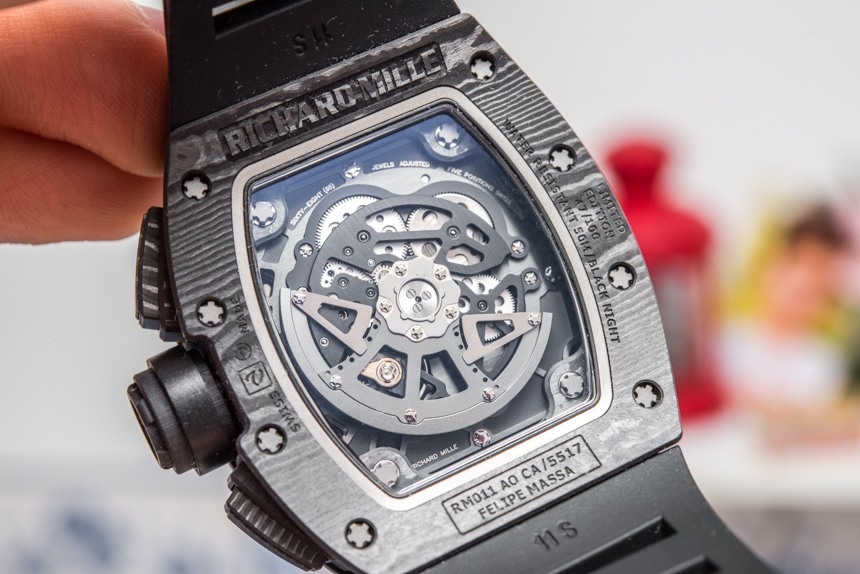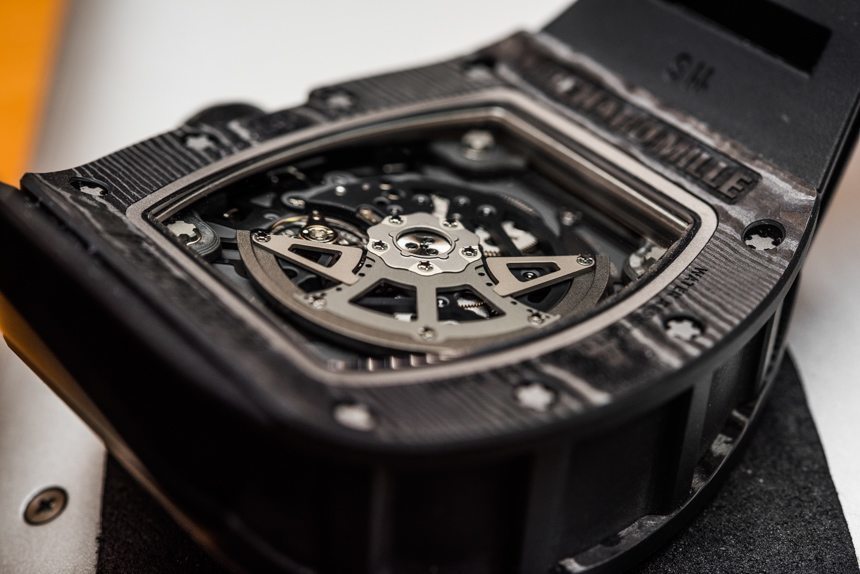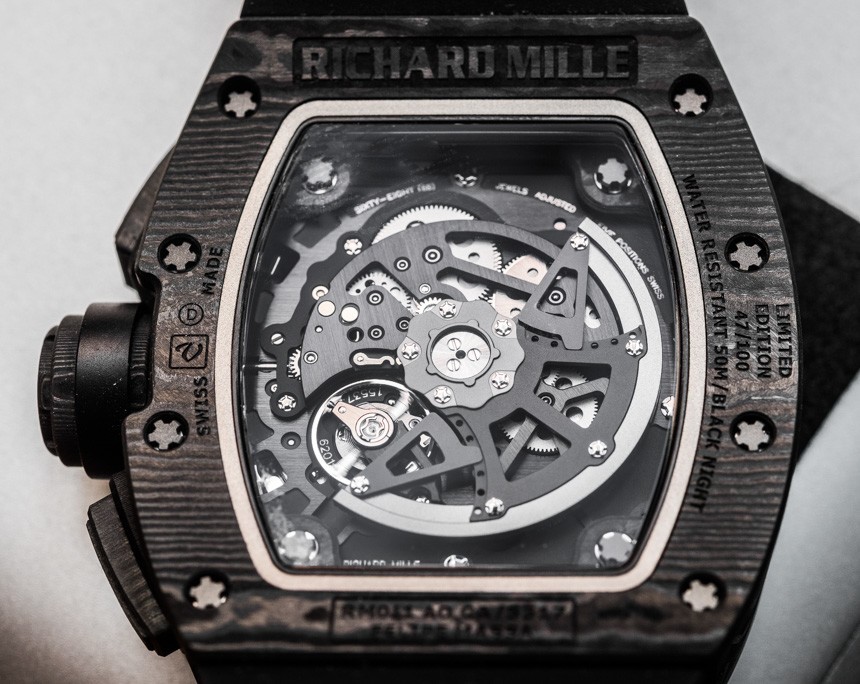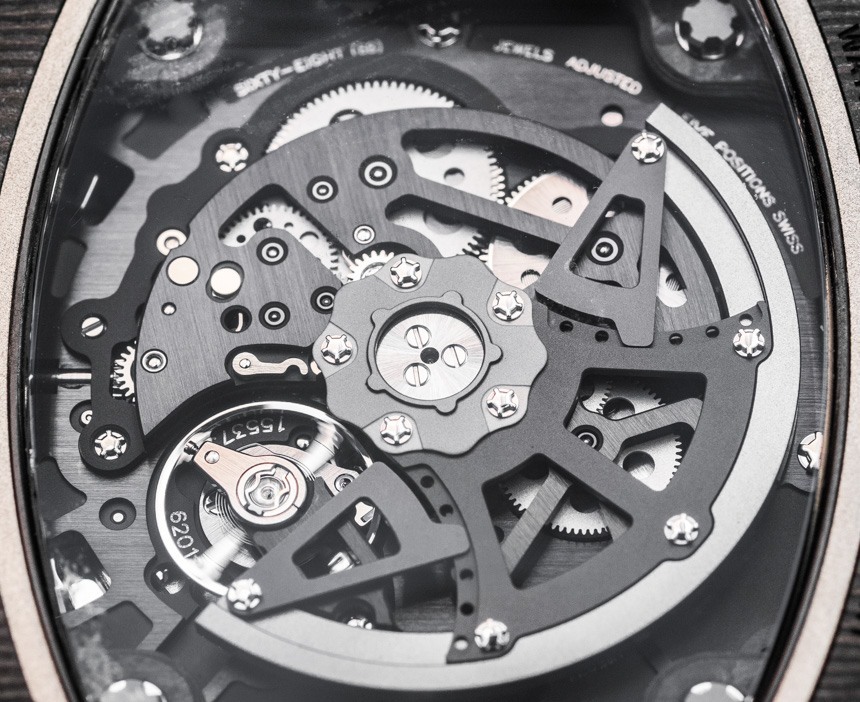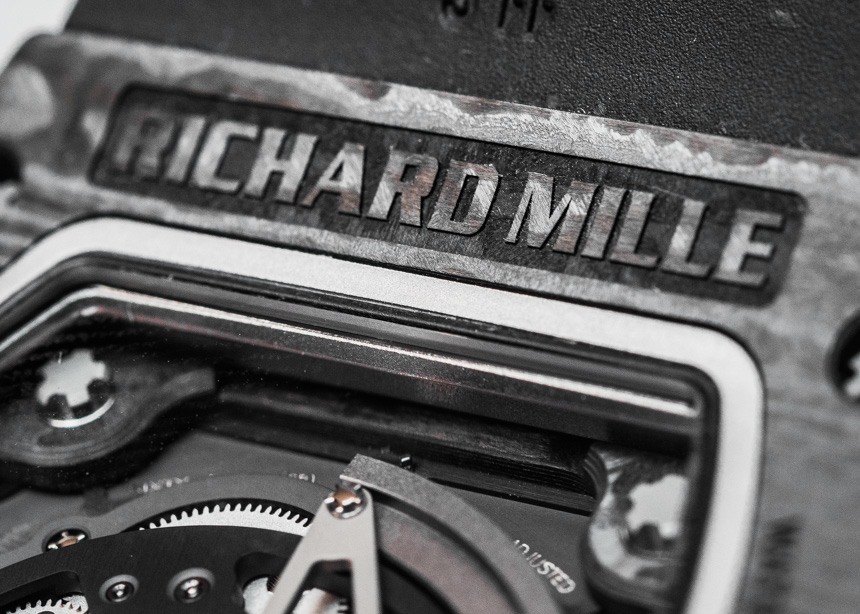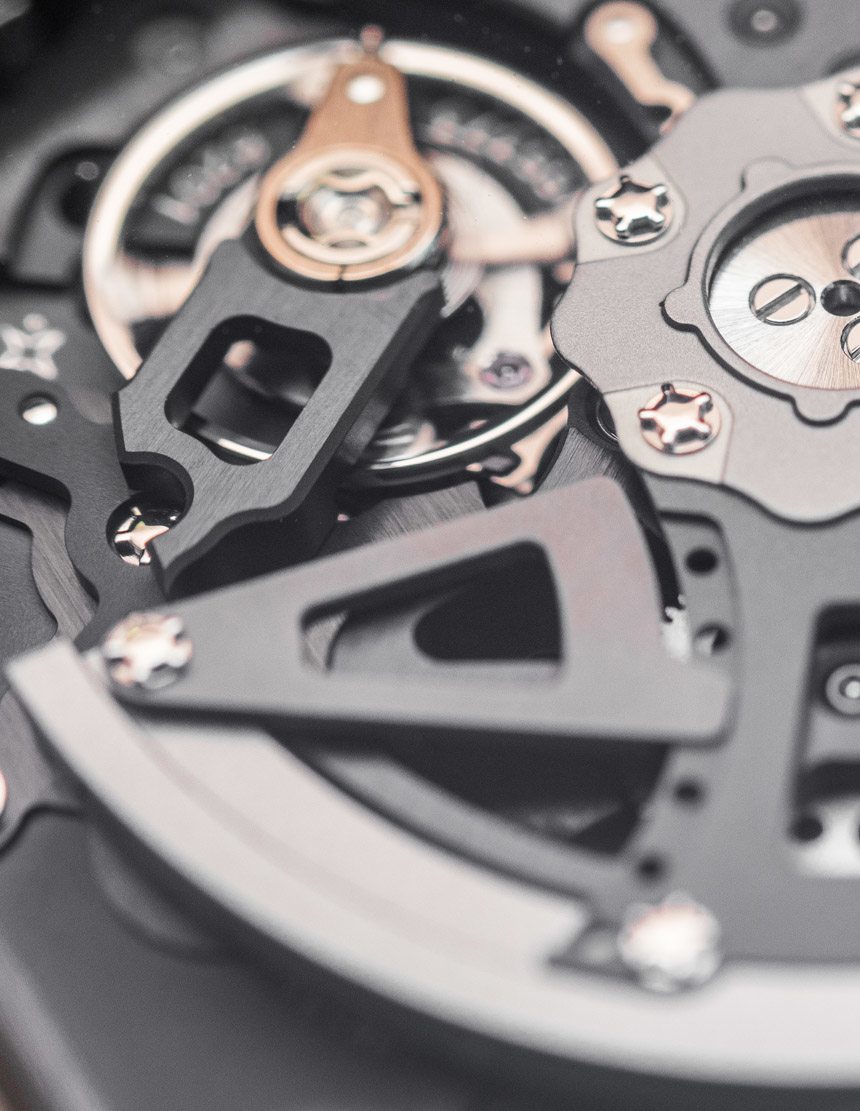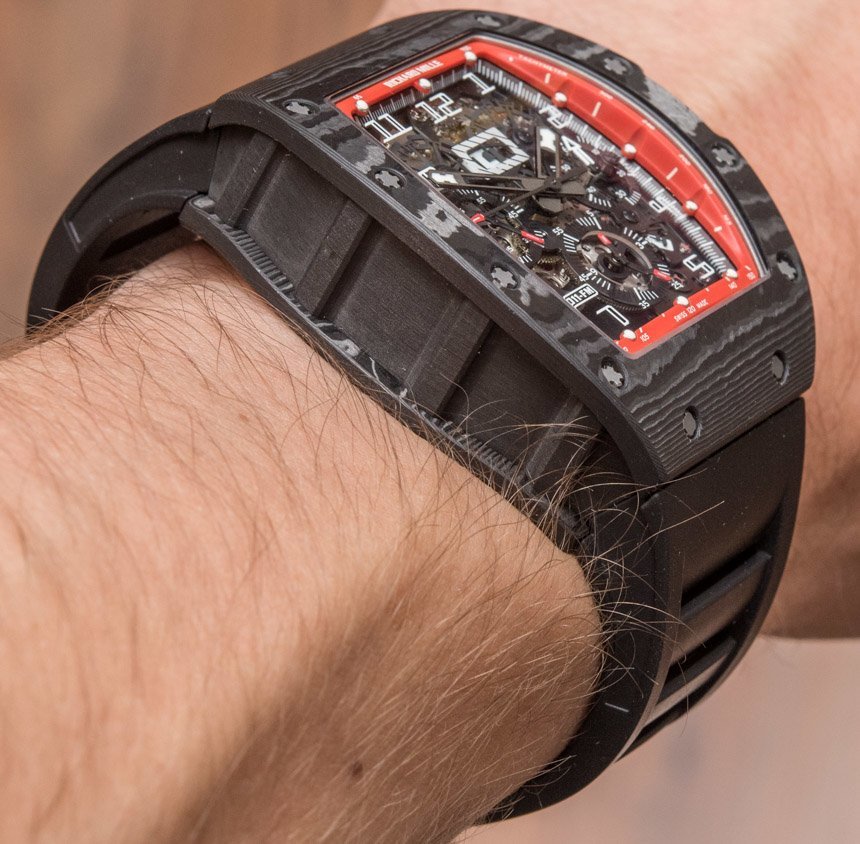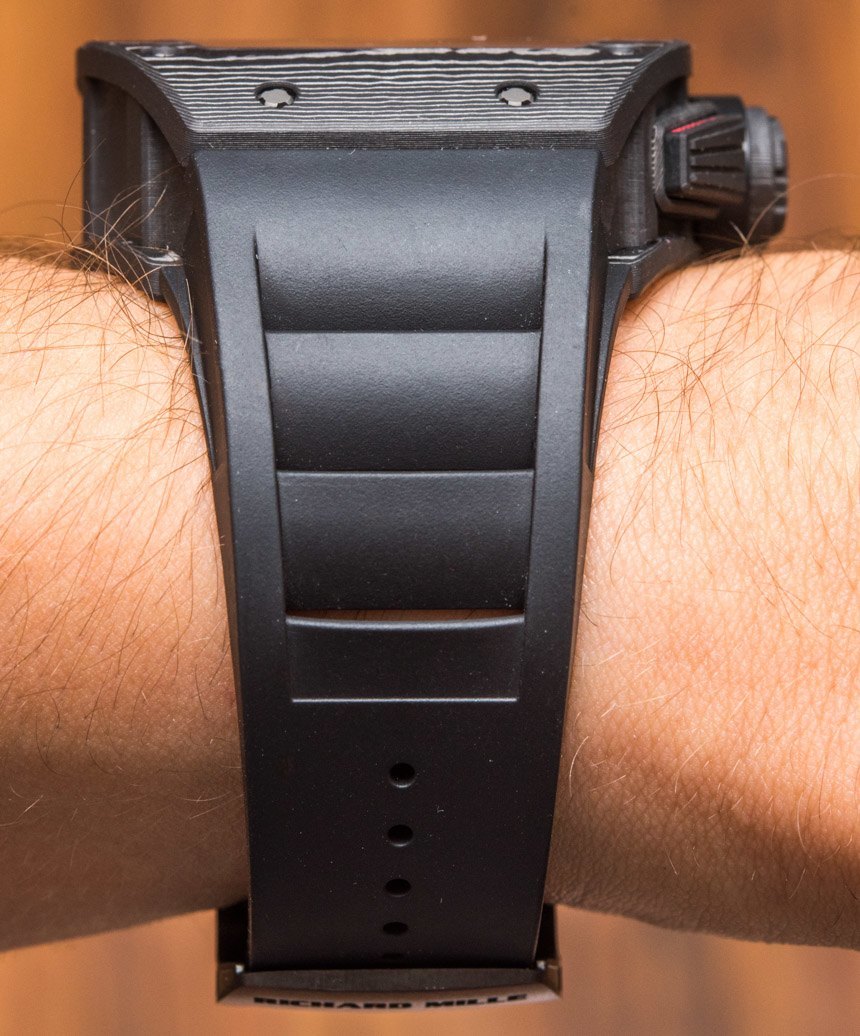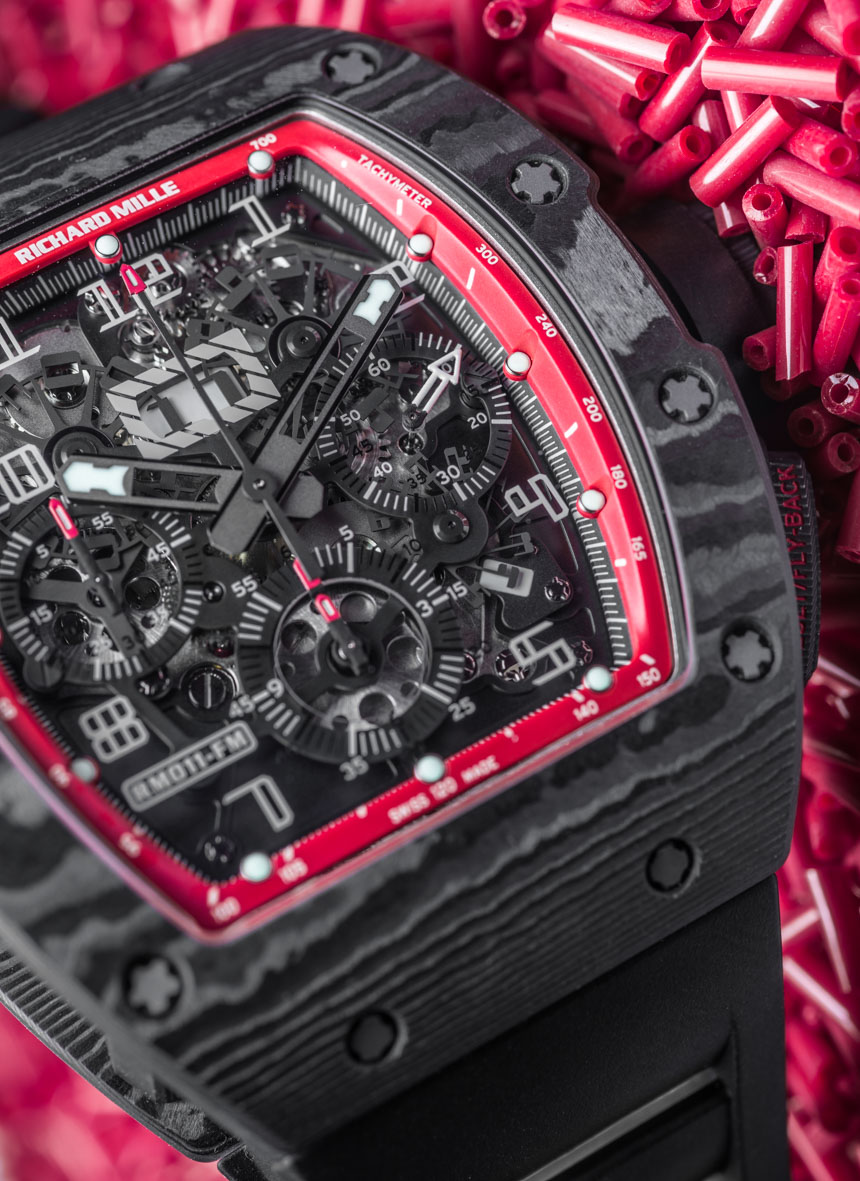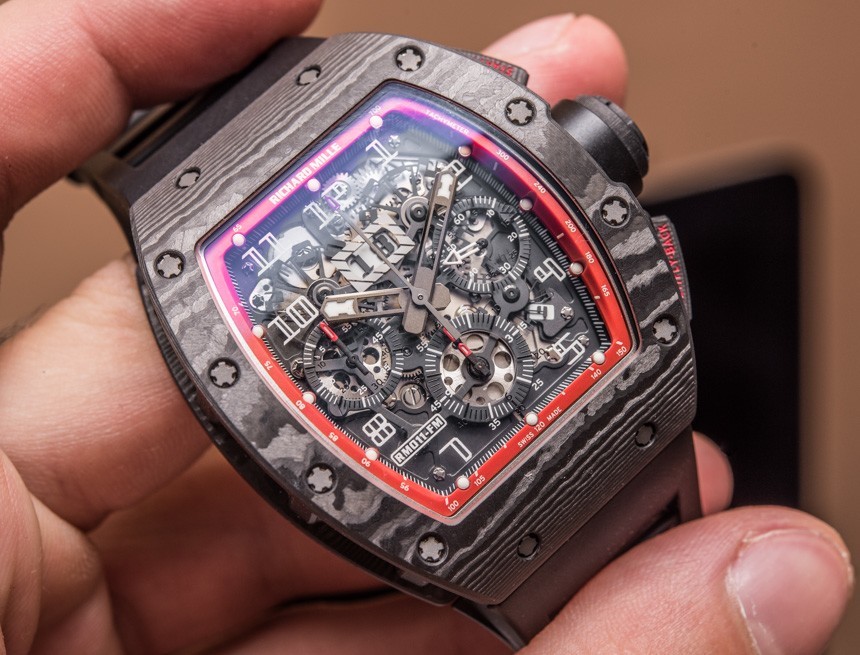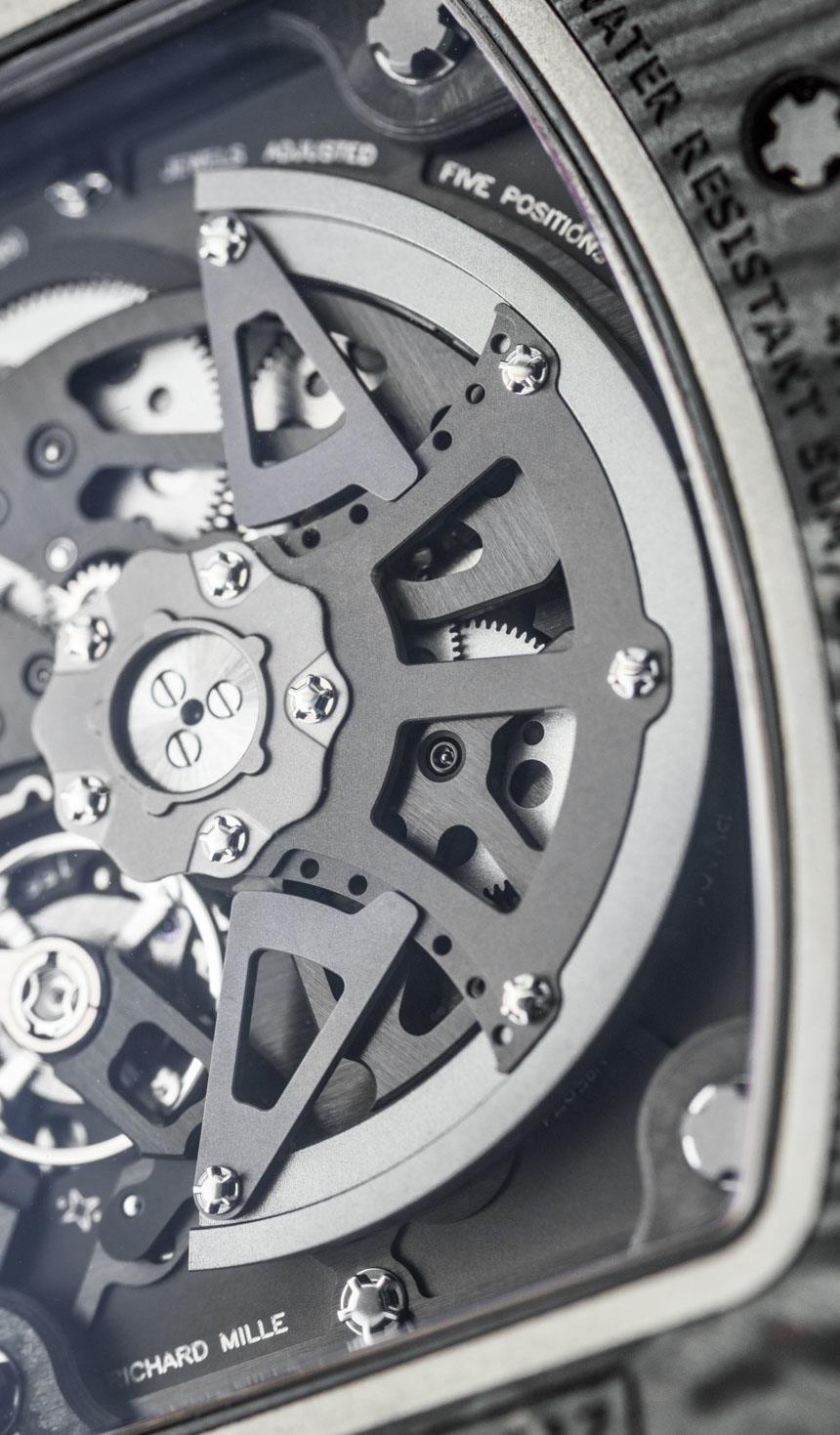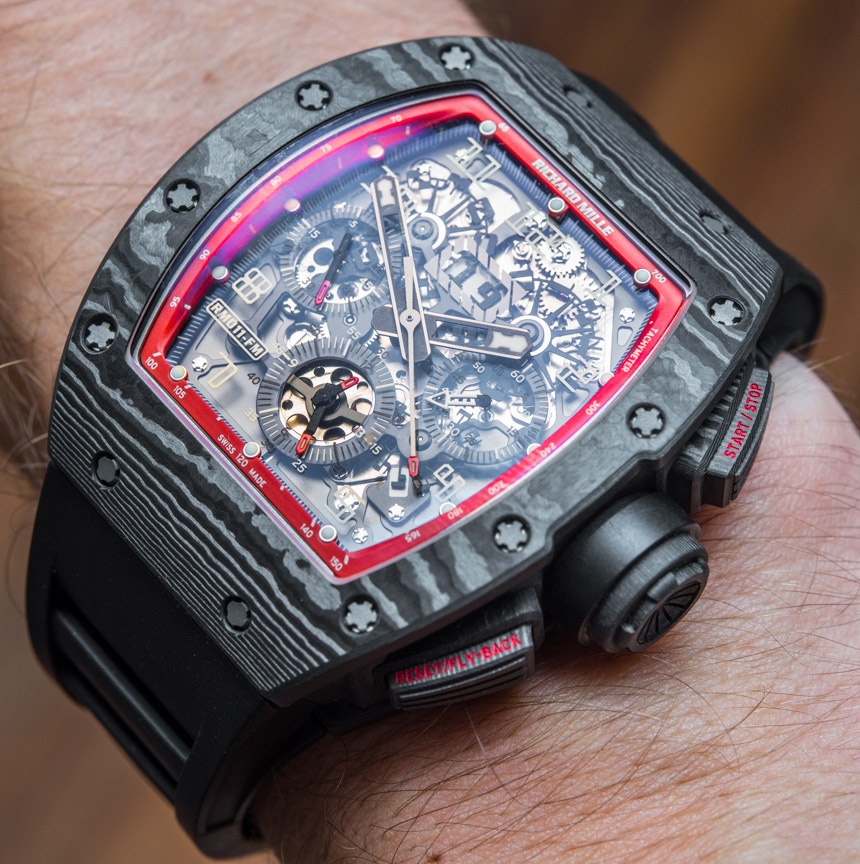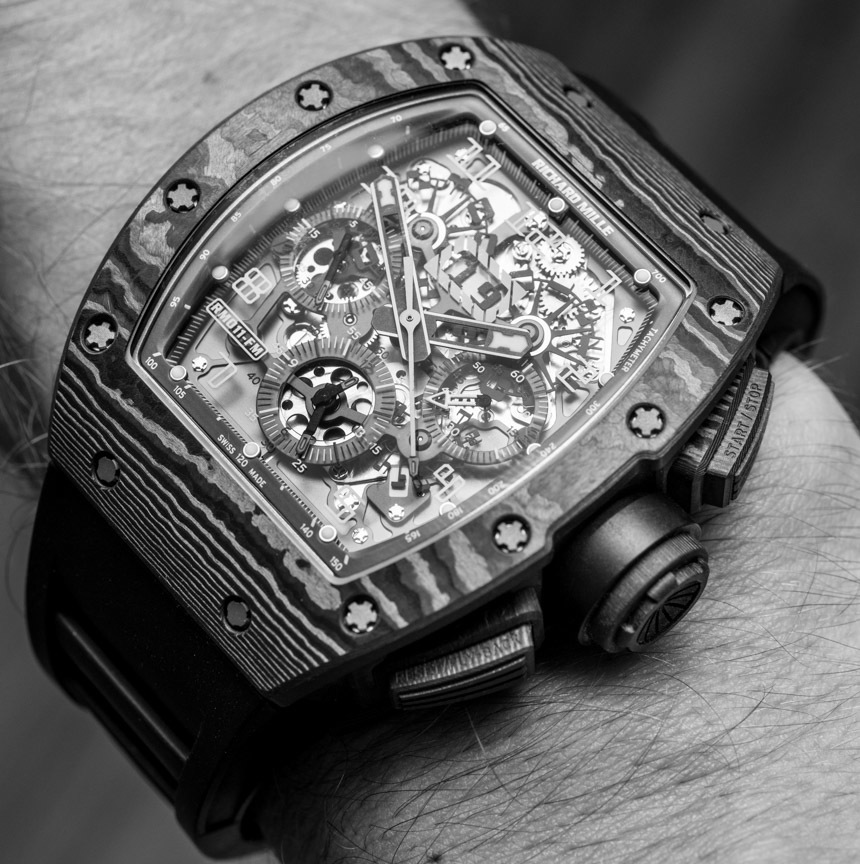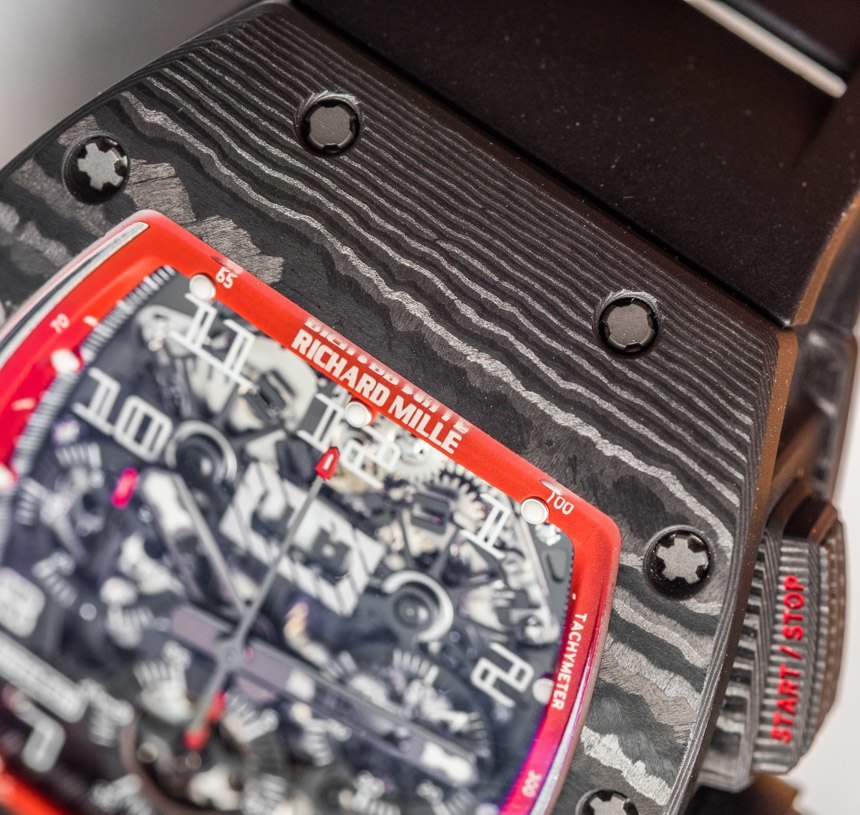
The case – composed of three main components: the case back, the middle-section, and the bezel – as well as all other parts (excluding the screws, of course) are made from NTPT. This includes the pushers for the chronograph, the large, rubber-framed crown, and even the thin frames for the pushers; they all show the visible patterns of this layered carbon fiber. Everything is meticulously machined, with perfectly even edges and recessed or relieved areas cut with laser accuracy.
The tolerances with which these parts fit together is beautiful even when scrutinized under a loupe or the macro lens of a camera – which is all the more impressive when considering that they were made from a material originally designed with completely different fields of use in mind, where strength and lightness were a priority, and not such precision in detailed execution.
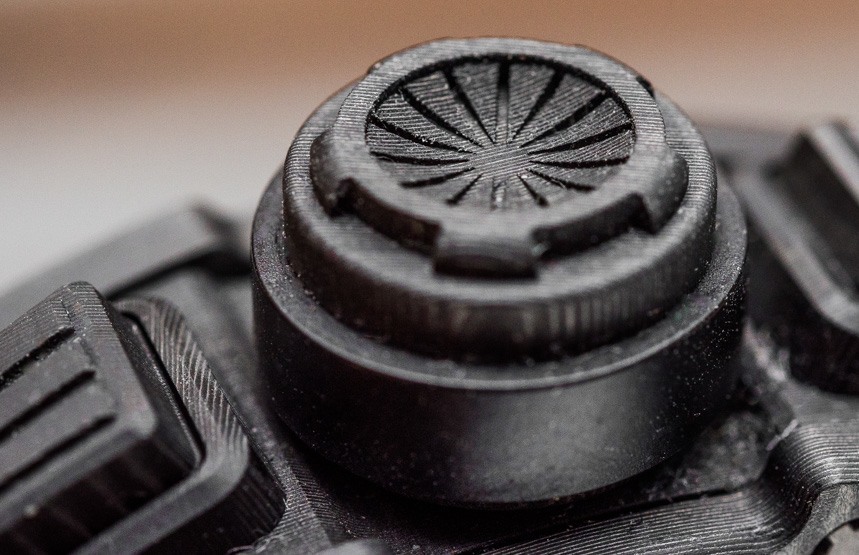
Weirdly, these fine details add up for the eye even when glancing at the watch from further away. The Richard Mille RM 011 is the closest I have ever come to wearing a perfectly rendered digital image, that was brought into reality in some weird, inexplicable way. The accuracy with which parts fit together and how they appear (not just on this, but on every other Richard Mille I have ever handled) seems almost uncanny, and shows that they were not only manufactured precisely enough to merely fit together and function, or to look good up close, but to be genuinely unbelievably accurately machined.
One could argue that, when looking at it from afar, there is too much going on in the design. It may look as though it was trying too hard to impress, and that takes away from these little details – but when once held in hand (or better: worn on the wrist), things do fall into place.
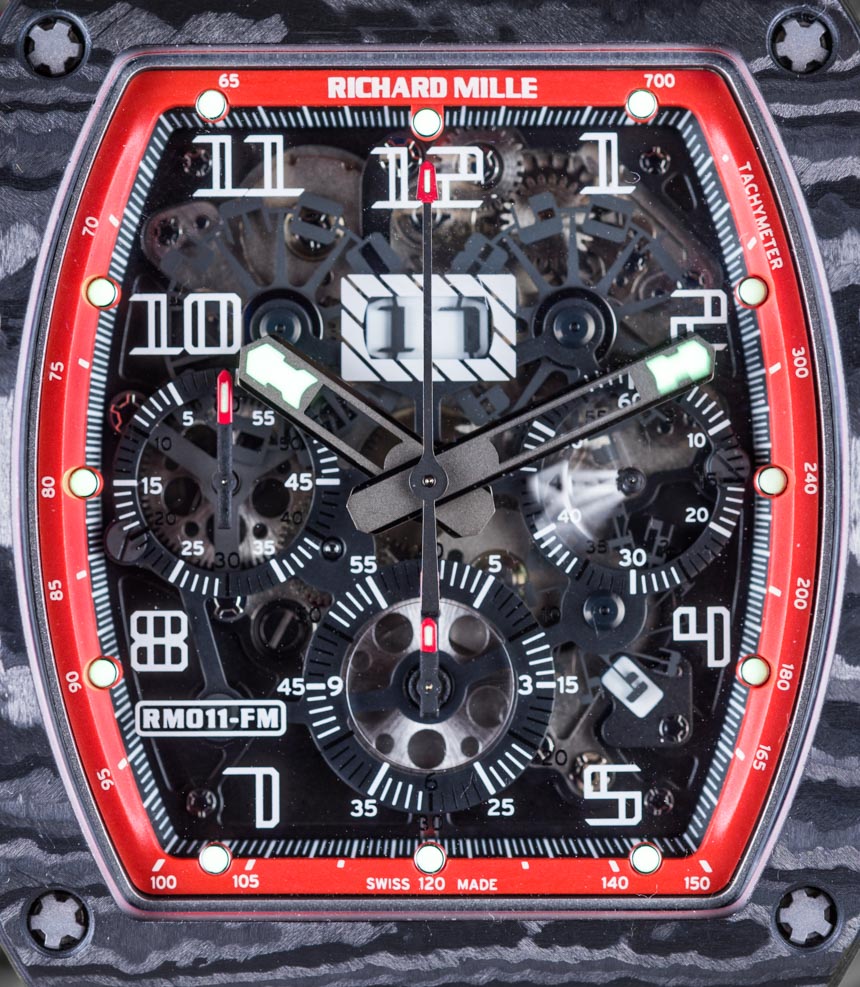
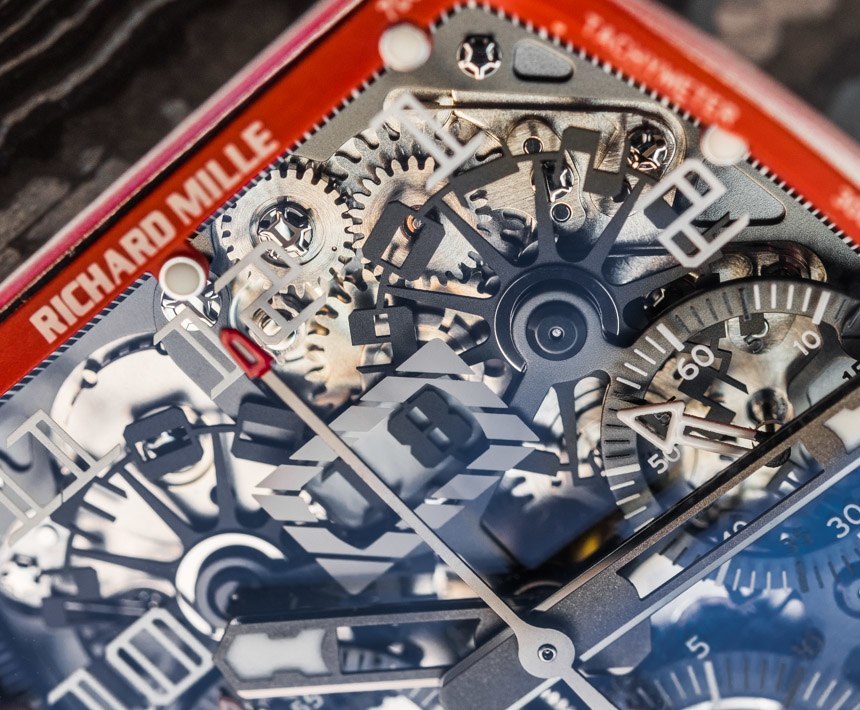
This attention to detail is, of course, also present on the dial itself: the hour and minute hands appear to be milled and not stamped, which makes them look incomparably more high-end than most other skeletonized hands. The cut-outs are sharp, and the hands are thick and have a lot of volume, while the alternating finishing of polished edges and grained center parts make them appear as luxurious as one would expect. Despite the skeletonized design and the lack of a traditional dial, legibility remains good – and, to be fair, considerably better than the images suggest.
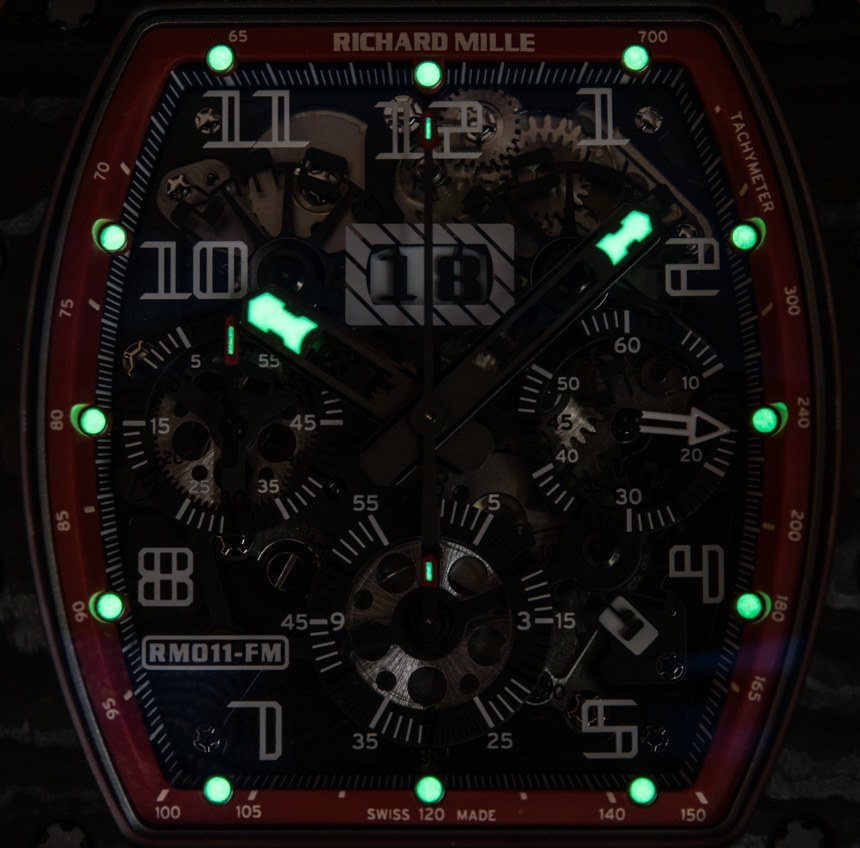
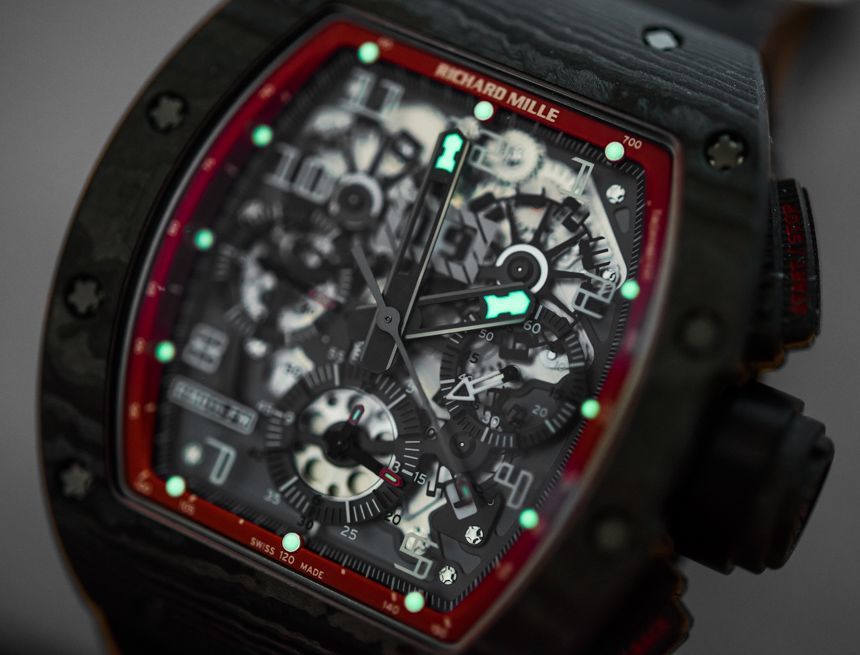
Instead of a solid, lacquered brass dial, the Richard Mille RM 011 Felipe Massa Black Night NTPT uses a pane of sapphire, with cut-outs for the pinions of the hands, of course. Given the curved profile of the case, the sapphire crystal set into the bezel follows that shape and is also curved, while the sapphire dial inside is perfectly flat. It sounds and indeed looks very fancy; however, having a curved piece of crystal over a flat one does appear a bit weird to the eye at times, making it difficult to pick out how the transparency and the layers of the dial work together.

In the center, below the 12 o’clock position is a large, jumping date display for the annual calendar – a mechanism that requires adjustment only at the end of every February – along with a month indicator between 4 and 5 o’clock. The more interesting bit is how the two separate chronograph sub-dials work: the one at 6 o’clock displays both the elapsed hours and minutes, while the sub-dial at 9 works as a 60-minute countdown timer. An interesting choice that, while rather gimmicky, helps establish the symmetrical design of the RM 011 while providing some – minimal – extra functionality over your typical, separated hours-minutes sub-dials found on most chronographs.
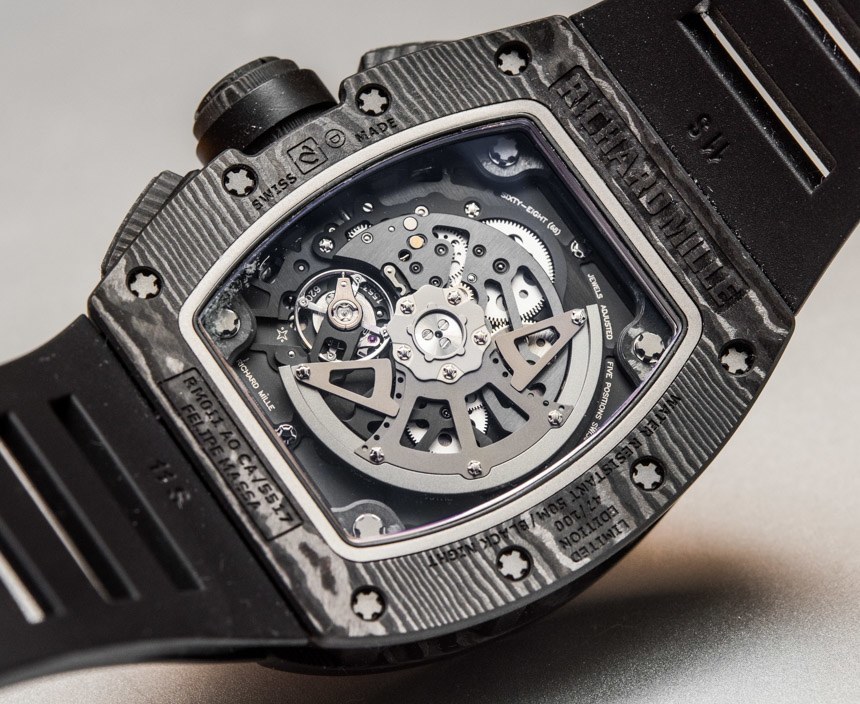
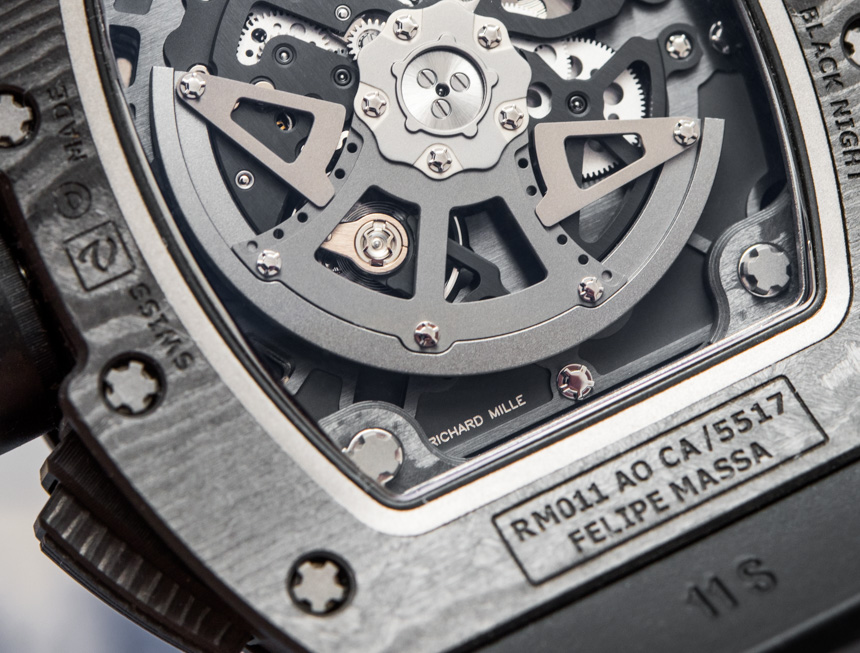
The movement that drives most Richard Mille RM 011 watches is the RMAC1 caliber, an automatic, annual calendar-equipped chronograph movement that is made in collaboration with Vaucher Manufacture. What makes it rather unique and rare is the use of not brass but titanium bridges, which have been anglaged and beveled by hand – although the high-tech look offered by the shaping of the parts as well as their greyscale surface treatments do kill every bit of traditional haute horlogerie vibe. The movement looks great but is more of a machine than your usual accumulation of nice and shiny polished surfaces. If there is one aspect of the RM 011 that I would like to see evolve, then it would have to be the movement. It looks impressive alright, but its almost perfectly monochromatic colorway and space-age-looking surfaces make it look a bit lifeless to me (by mechanical standards, that is).
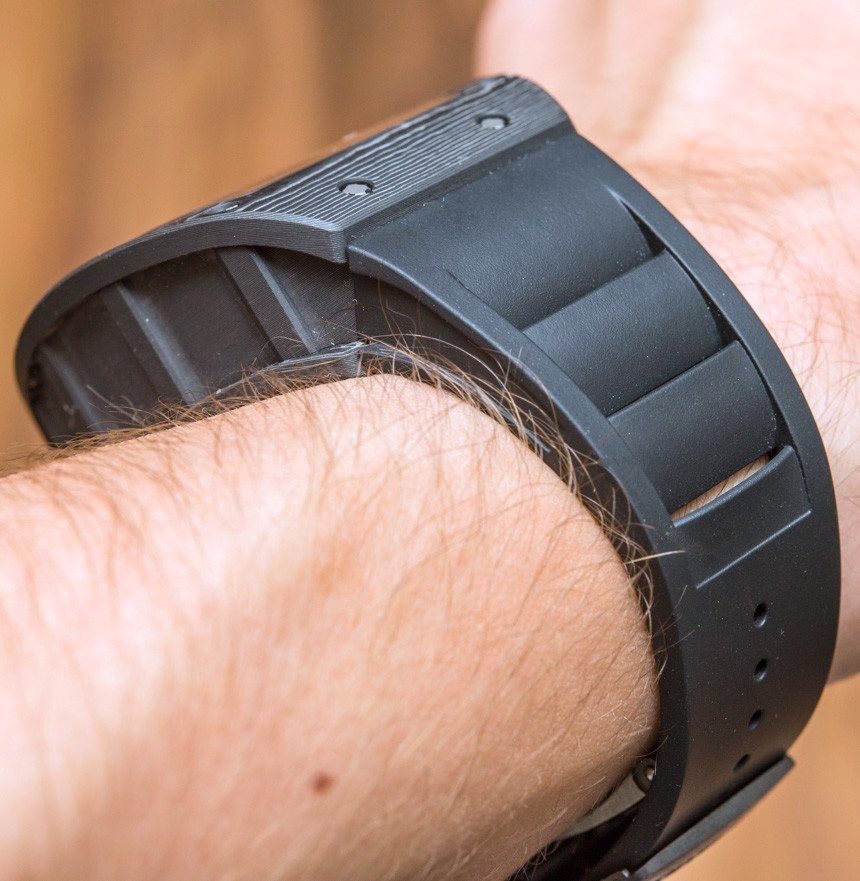
The RM 011 case measures 50.00 millimeters lug to lug (although the design clearly omits this traditional component), is 40 millimeters wide, and because of its curved profile, 16.15 millimeters thick. Strap integration is excellent – but that can hardly be a surprise, based on what I learned from one of ProArt’s engineers: that it took 5 years to develop how the Richard Mille rubber straps are seamlessly integrated into the case. As far as wearability is concerned, their work was worth it, as the light and relatively reasonably sized Richard Mille RM 011 Felipe Massa Black Night NTPT Carbon sits snugly and comfortably on the wrist.
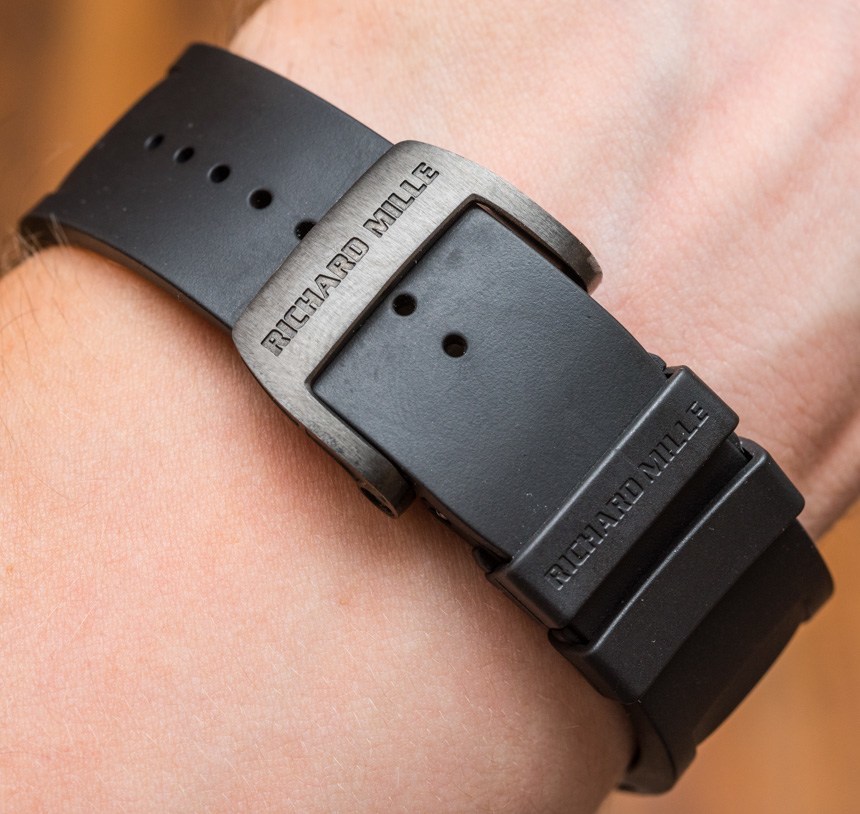
While the rectangular cutouts in the upper segments of the straps look cool, they turned out to be genuinely functional as well, as they did actually allow for a fair bit of ventilation, saving my wrists from sweating under the snug fit of the rubber strap. Needless to say, Richard Mille offers this type of strap in a wide range of colors – which will probably make buyers wish for a quick strap release system that would allow them to easily switch between their straps without having to use a special screwdriver or, even worse, to bring their watches into a boutique.
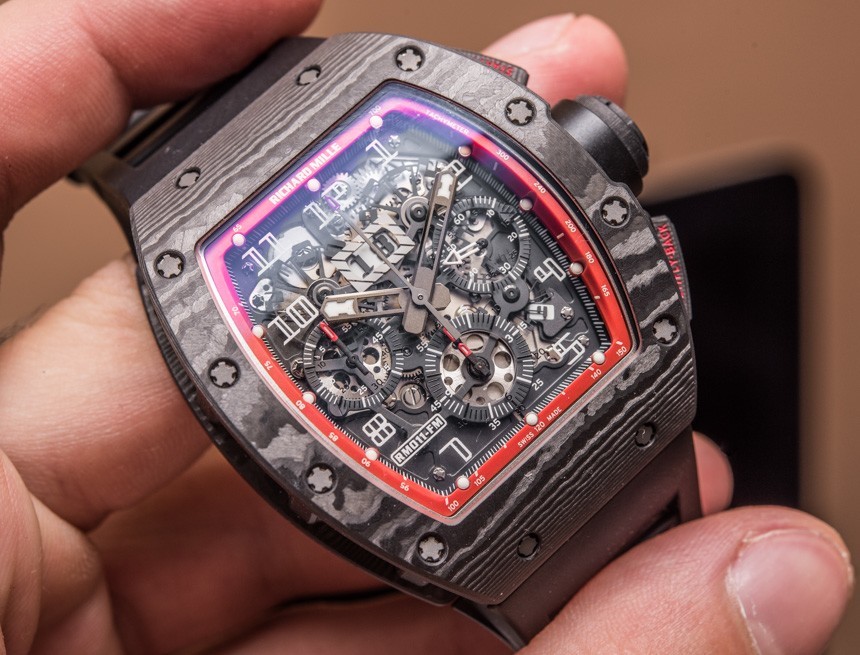
So, what is it that the Richard Mille RM 011 Felipe Massa Black Night NTPT can deliver to those who are always looking for the ultimate from those modern brands constantly pushing the design and technological envelope? This NTPT iteration is an expectedly unexpected – in other words, novel – development to the established RM 011 collection. It uses a fascinating new material that is light, offers some unique aesthetic properties, and should prove to be very durable in the long run. Matched to it are the usual properties of a Richard Mille watch: a complicated movement, superb wearing comfort, a limited run of 100 pieces, and a price tag hardly fathomable to those of us who have not (yet!) made our down-payments for the McLaren P1… That price for the Richard Mille RM 011 Felipe Massa Black Night NTPT being 141,000 CHF including tax. richardmille.com
Necessary Data
>Brand: Richard Mille
>Model: RM 011 Felipe Massa Black Night NTPT
>Price: 141,000 CHF
>Size: 40mm*50mm*16.15mm
>Movement: Richard Mille RMAC1
>Materials: NTPT Carbon case, titanium movement plates
>Would reviewer personally wear it: Definitely.
>Friend we’d recommend it to: The one into (actually buying) the latest supercars.
>Best characteristic of watch: High-tech case, fantastic attention to detail, superb wearing comfort.
>Worst characteristic of watch: The movement struggles to keep up aesthetically with major other elements of the watch.

